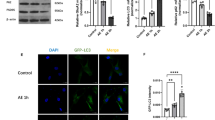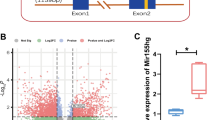Abstract
Inhalation anesthetic isoflurane may cause an increased risk of cognitive impairment. Previous studies have indicated that this cognitive decline is associated with neuroinflammation mediated by high mobility group box 1 (HMGB1). HMGB1 is released from cells and acts as a damage-associated molecule in neurodegenerative diseases. However, the effect of intracellular HMGB1 during emulsified isoflurane (EI) exposure is poorly understood. The purpose of this study was to investigate the effect of autophagy on neuroprotection, evaluate variation of HMGB1, and determine its role in autophagic flux after EI exposure in vitro. We observed that EI decreased cell viability in a concentration-dependent manner, accompanied by an increase in autophagic flux. EI exposure also elevates the HMGB1 level in cytoplasm. Further, cytosolic HMGB1 was necessary for autophagy by perturbing the beclin1-Bcl-2 interaction. Most importantly, autophagy induction by rapamycin alleviated EI-provoked cell injury, and HMGB1 knockdown induced autophagy inhibition, which exacerbated cell damage. Based on these findings, we propose that autophagic flux is sustained and upregulated in response to EI exposure by increased cytosolic HMGB1, and that autophagy activation serves as a protective mechanism against EI-induced cytotoxicity. Thus, the complex roles of HMGB1 make it pivotal in reducing EI-induced neuronal damage.






Similar content being viewed by others
References
Bianchi SL, Tran T, Liu C, Lin S, Li Y, Keller JM, Eckenhoff RG, Eckenhoff MF (2008) Brain and behavior changes in 12-month-old Tg2576 and nontransgenic mice exposed to anesthetics. Neurobiol Aging 29(7):1002–1010. https://doi.org/10.1016/j.neurobiolaging.2007.02.009
Zhang Y, Xu Z, Wang H, Dong Y, Shi HN, Culley DJ, Crosby G, Marcantonio ER, Tanzi RE, Xie Z (2012) Anesthetics isoflurane and desflurane differently affect mitochondrial function, learning, and memory. Ann Neurol 71(5):687–698. https://doi.org/10.1002/ana.23536
Ge HW, Hu WW, Ma LL, Kong FJ (2015) Endoplasmic reticulum stress pathway mediates isoflurane-induced neuroapoptosis and cognitive impairments in aged rats. Physiol Behav 151:16–23. https://doi.org/10.1016/j.physbeh.2015.07.008
Lin D, Zuo Z (2011) Isoflurane induces hippocampal cell injury and cognitive impairments in adult rats. Neuropharmacology 61(8):1354–1359. https://doi.org/10.1016/j.neuropharm.2011.08.011
Shen X, Dong Y, Xu Z, Wang H, Miao C, Soriano SG, Sun D, Baxter MG, Zhang Y, Xie Z (2013) Selective anesthesia-induced neuroinflammation in developing mouse brain and cognitive impairment. Anesthesiology 118(3):502–515. https://doi.org/10.1097/ALN.0b013e3182834d77
Andersson U, Tracey KJ (2011) HMGB1 is a therapeutic target for sterile inflammation and infection. Annu Rev Immunol 29:139–162. https://doi.org/10.1146/annurev-immunol-030409-101323
Fang P, Schachner M, Shen YQ (2012) HMGB1 in development and diseases of the central nervous system. Mol Neurobiol 45(3):499–506. https://doi.org/10.1007/s12035-012-8264-y
Kang R, Chen R, Zhang Q, Hou W, Wu S, Cao L, Huang J, Yu Y, Fan XG, Yan Z, Sun X, Wang H, Wang Q, Tsung A, Billiar TR, Zeh HJ 3rd, Lotze MT, Tang D (2014) HMGB1 in health and disease. Mol Asp Med 40:1–116. https://doi.org/10.1016/j.mam.2014.05.001
Klune JR, Dhupar R, Cardinal J, Billiar TR, Tsung A (2008) HMGB1: endogenous danger signaling. Mol Med 14(7–8):476–484. https://doi.org/10.2119/2008-00034.Klune
Parzych KR, Klionsky DJ (2014) An overview of autophagy: morphology, mechanism, and regulation. Antioxid Redox Signal 20(3):460–473. https://doi.org/10.1089/ars.2013.5371
Tooze SA, Schiavo G (2008) Liaisons dangereuses: autophagy, neuronal survival and neurodegeneration. Curr Opin Neurobiol 18(5):504–515. https://doi.org/10.1016/j.conb.2008.09.015
Harris HE, Andersson U, Pisetsky DS (2012) HMGB1: a multifunctional alarmin driving autoimmune and inflammatory disease. Nat Rev Rheumatol 8(4):195–202. https://doi.org/10.1038/nrrheum.2011.222
Lotze MT, Tracey KJ (2005) High-mobility group box 1 protein (HMGB1): nuclear weapon in the immune arsenal. Nat Rev Immunol 5(4):331–342. https://doi.org/10.1038/nri1594
Terrando N, Yang T, Wang X, Fang J, Cao M, Andersson U, Erlandsson HH, Ouyang W, Tong J (2016) Systemic HMGB1 neutralization prevents postoperative neurocognitive dysfunction in aged rats. Front Immunol 7:441. https://doi.org/10.3389/fimmu.2016.00441
Chen XH, Chen DT, Huang XM, Chen YH, Pan JH, Zheng XC, Zeng WA (2018) Dexmedetomidine protects against chemical hypoxia-induced neurotoxicity in differentiated PC12 cells via inhibition of NADPH oxidase 2-mediated oxidative stress. Neurotox Res 35(1):139–149. https://doi.org/10.1007/s12640-018-9938-7
Pan X, Yan D, Wang D, Wu X, Zhao W, Lu Q, Yan H (2017) Mitochondrion-mediated apoptosis induced by acrylamide is regulated by a balance between Nrf2 antioxidant and MAPK signaling pathways in PC12 cells. Mol Neurobiol 54(6):4781–4794. https://doi.org/10.1007/s12035-016-0021-1
Kimura S, Fujita N, Noda T, Yoshimori T (2009) Monitoring autophagy in mammalian cultured cells through the dynamics of LC3. Methods Enzymol 452:1–12. https://doi.org/10.1016/s0076-6879(08)03601-x
Bjorkoy G, Lamark T, Brech A, Outzen H, Perander M, Overvatn A, Stenmark H, Johansen T (2005) p62/SQSTM1 forms protein aggregates degraded by autophagy and has a protective effect on huntingtin-induced cell death. J Cell Biol 171(4):603–614. https://doi.org/10.1083/jcb.200507002
Kimura S, Noda T, Yoshimori T (2007) Dissection of the autophagosome maturation process by a novel reporter protein, tandem fluorescent-tagged LC3. Autophagy 3(5):452–460
Porter K, Nallathambi J, Lin Y, Liton PB (2013) Lysosomal basification and decreased autophagic flux in oxidatively stressed trabecular meshwork cells: implications for glaucoma pathogenesis. Autophagy 9(4):581–594. https://doi.org/10.4161/auto.23568
Yang YP, Hu LF, Zheng HF, Mao CJ, Hu WD, Xiong KP, Wang F, Liu CF (2013) Application and interpretation of current autophagy inhibitors and activators. Acta Pharmacol Sin 34(5):625–635. https://doi.org/10.1038/aps.2013.5
Lu Y, Wu X, Dong Y, Xu Z, Zhang Y, Xie Z (2010) Anesthetic sevoflurane causes neurotoxicity differently in neonatal naive and Alzheimer disease transgenic mice. Anesthesiology 112(6):1404–1416. https://doi.org/10.1097/ALN.0b013e3181d94de1
Zhang L, Zhang J, Yang L, Dong Y, Zhang Y, Xie Z (2013) Isoflurane and sevoflurane increase interleukin-6 levels through the nuclear factor-kappa B pathway in neuroglioma cells. Br J Anaesth 110(Suppl 1):i82–i91. https://doi.org/10.1093/bja/aet115
Galluzzi L, Vicencio JM, Kepp O, Tasdemir E, Maiuri MC, Kroemer G (2008) To die or not to die: that is the autophagic question. Curr Mol Med 8(2):78–91
Carloni S, Buonocore G, Balduini W (2008) Protective role of autophagy in neonatal hypoxia-ischemia induced brain injury. Neurobiol Dis 32(3):329–339. https://doi.org/10.1016/j.nbd.2008.07.022
Martinez-Vicente M (2015) Autophagy in neurodegenerative diseases: from pathogenic dysfunction to therapeutic modulation. Semin Cell Dev Biol 40:115–126. https://doi.org/10.1016/j.semcdb.2015.03.005
Chen G, Ke Z, Xu M, Liao M, Wang X, Qi Y, Zhang T, Frank JA, Bower KA, Shi X, Luo J (2012) Autophagy is a protective response to ethanol neurotoxicity. Autophagy 8(11):1577–1589. https://doi.org/10.4161/auto.21376
Xiong J, Kong Q, Dai L, Ma H, Cao X, Liu L, Ding Z (2017) Autophagy activated by tuberin/mTOR/p70S6K suppression is a protective mechanism against local anaesthetics neurotoxicity. J Cell Mol Med 21(3):579–587. https://doi.org/10.1111/jcmm.13003
Komita M, Jin H, Aoe T (2013) The effect of endoplasmic reticulum stress on neurotoxicity caused by inhaled anesthetics. Anesth Analg 117(5):1197–1204. https://doi.org/10.1213/ANE.0b013e3182a74773
Li G, Yu B (2014) Elevation of protective autophagy as a potential way for preventing developmental neurotoxicity of general anesthetics. Med Hypotheses 82(2):177–180. https://doi.org/10.1016/j.mehy.2013.11.032
Kong ZH, Chen X, Hua HP, Liang L, Liu LJ (2017) The oral pretreatment of glycyrrhizin prevents surgery-induced cognitive impairment in aged mice by reducing neuroinflammation and alzheimer’s-related pathology via HMGB1 inhibition. J Mol Neurosci 63(3–4):385–395. https://doi.org/10.1007/s12031-017-0989-7
Wang W, Chen X, Zhang J, Zhao Y, Li S, Tan L, Gao J, Fang X, Luo A (2016) Glycyrrhizin attenuates isoflurane-induced cognitive deficits in neonatal rats via its anti-inflammatory activity. Neuroscience 316:328–336. https://doi.org/10.1016/j.neuroscience.2015.11.001
Zhu X, Messer JS, Wang Y, Lin F, Cham CM, Chang J, Billiar TR, Lotze MT, Boone DL, Chang EB (2015) Cytosolic HMGB1 controls the cellular autophagy/apoptosis checkpoint during inflammation. J Clin Investig 125(3):1098–1110. https://doi.org/10.1172/jci76344
Kornblit B, Munthe-Fog L, Madsen HO, Strom J, Vindelov L, Garred P (2008) Association of HMGB1 polymorphisms with outcome in patients with systemic inflammatory response syndrome. Crit Care 12(3):R83. https://doi.org/10.1186/cc6935
Tang D, Kang R, Livesey KM, Cheh CW, Farkas A, Loughran P, Hoppe G, Bianchi ME, Tracey KJ, Zeh HJ 3rd, Lotze MT (2010) Endogenous HMGB1 regulates autophagy. J Cell Biol 190(5):881–892. https://doi.org/10.1083/jcb.200911078
Wang K, Huang J, Xie W, Huang L, Zhong C, Chen Z (2016) Beclin1 and HMGB1 ameliorate the alpha-synuclein-mediated autophagy inhibition in PC12 cells. Diagn Pathol 11:15. https://doi.org/10.1186/s13000-016-0459-5
Guan Y, Li Y, Zhao G, Li Y (2018) HMGB1 promotes the starvation-induced autophagic degradation of alpha-synuclein in SH-SY5Y cells Atg 5-dependently. Life Sci 202:1–10. https://doi.org/10.1016/j.lfs.2018.03.031
Erlich S, Shohami E, Pinkas-Kramarski R (2006) Neurodegeneration induces upregulation of Beclin 1. Autophagy 2(1):49–51
Marquez RT, Xu L (2012) Bcl-2:Beclin 1 complex: multiple, mechanisms regulating autophagy/apoptosis toggle switch. Am J Cancer Res 2(2):214–221
Huebener P, Gwak GY, Pradere JP, Quinzii CM, Friedman R, Lin CS, Trent CM, Mederacke I, Zhao E, Dapito DH, Lin Y, Goldberg IJ, Czaja MJ, Schwabe RF (2014) High-mobility group box 1 is dispensable for autophagy, mitochondrial quality control, and organ function in vivo. Cell Metab 19(3):539–547. https://doi.org/10.1016/j.cmet.2014.01.014
Acknowledgements
We would like to thank Dr. Shumei Ma at Jilin University for helping with experimental platform. We would like to thank Editage (http://www.editage.com) for English language editing.
Funding
This work was supported by Natural Science Foundation of Jilin Province (Grant No. 3T1158303430). The funders had no role in study design, data collection and analysis, decision to publish or preparation of the manuscript.
Author information
Authors and Affiliations
Corresponding author
Ethics declarations
Conflict of interest
All authors declare that they have no conflict of interest.
Additional information
Publisher’s Note
Springer Nature remains neutral with regard to jurisdictional claims in published maps and institutional affiliations.
Rights and permissions
About this article
Cite this article
Liu, Rz., Li, T. & Zhao, Gq. Cytosolic HMGB1 Mediates Autophagy Activation in an Emulsified Isoflurane Anesthesia Cell Model. Neurochem Res 44, 1090–1100 (2019). https://doi.org/10.1007/s11064-019-02740-5
Received:
Revised:
Accepted:
Published:
Issue Date:
DOI: https://doi.org/10.1007/s11064-019-02740-5




